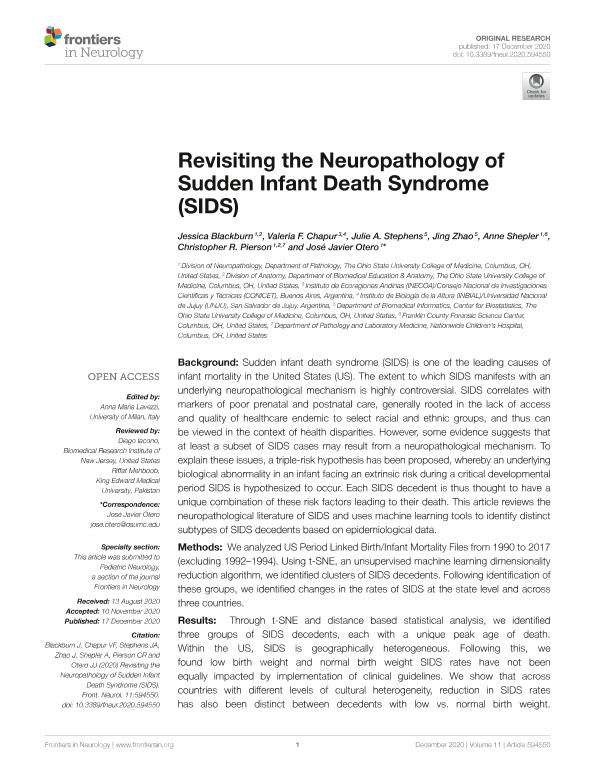Mostrar el registro sencillo del ítem
dc.contributor.author
Blackburn, Jessica
dc.contributor.author
Chapur, Valeria Fernanda

dc.contributor.author
Stephens, Julie A.
dc.contributor.author
Zhao, Jing
dc.contributor.author
Shepler, Anne
dc.contributor.author
Pierson, Christopher R.
dc.contributor.author
Otero, José Javier
dc.date.available
2021-10-05T23:26:09Z
dc.date.issued
2020-12
dc.identifier.citation
Blackburn, Jessica; Chapur, Valeria Fernanda; Stephens, Julie A.; Zhao, Jing; Shepler, Anne; et al.; Revisiting the neuropathology of sudden infant death syndrome (SIDS); Frontiers Media; Frontiers in Neurology; 11; 594550; 12-2020; 1-12
dc.identifier.issn
1664-2295
dc.identifier.uri
http://hdl.handle.net/11336/142769
dc.description.abstract
Background: Sudden infant death syndrome (SIDS) is one of the leading causes of infant mortality in the United States (US). The extent to which SIDS manifests with an underlying neuropathological mechanism is highly controversial. SIDS correlates with markers of poor prenatal and postnatal care, generally rooted in the lack of access and quality of healthcare endemic to select racial and ethnic groups, and thus can be viewed in the context of health disparities. However, some evidence suggests that at least a subset of SIDS cases may result from a neuropathological mechanism. To explain these issues, a triple-risk hypothesis has been proposed, whereby an underlying biological abnormality in an infant facing an extrinsic risk during a critical developmental period SIDS is hypothesized to occur. Each SIDS decedent is thus thought to have a unique combination of these risk factors leading to their death. This article reviews the neuropathological literature of SIDS and uses machine learning tools to identify distinct subtypes of SIDS decedents based on epidemiological data. Methods: We analyzed US Period Linked Birth/Infant Mortality Files from 1990 to 2017 (excluding 1992–1994). Using t-SNE, an unsupervised machine learning dimensionality reduction algorithm, we identified clusters of SIDS decedents. Following identification of these groups, we identified changes in the rates of SIDS at the state level and across three countries. Results: Through t-SNE and distance based statistical analysis, we identified three groups of SIDS decedents, each with a unique peak age of death. Within the US, SIDS is geographically heterogeneous. Following this, we found low birth weight and normal birth weight SIDS rates have not been equally impacted by implementation of clinical guidelines. We show that across countries with different levels of cultural heterogeneity, reduction in SIDS rates has also been distinct between decedents with low vs. normal birth weight. Conclusions: Different epidemiological and extrinsic risk factors exist based on the three unique SIDS groups we identified with t-SNE and distance based statistical measurements. Clinical guidelines have not equally impacted the groups, and normal birth weight infants comprise more of the cases of SIDS even though low birth weight infants have a higher SIDS rate.
dc.format
application/pdf
dc.language.iso
eng
dc.publisher
Frontiers Media

dc.rights
info:eu-repo/semantics/openAccess
dc.rights.uri
https://creativecommons.org/licenses/by-nc-sa/2.5/ar/
dc.subject
SUDDEN INFANT DEATH SYNDROME (SIDS)
dc.subject
NEUROPATHOLOGY
dc.subject
CLUSTER ANALYSIS
dc.subject
INFANT MORTALITY RATE
dc.subject
INFANT DEATH
dc.subject.classification
Otras Ciencias de la Computación e Información

dc.subject.classification
Ciencias de la Computación e Información

dc.subject.classification
CIENCIAS NATURALES Y EXACTAS

dc.title
Revisiting the neuropathology of sudden infant death syndrome (SIDS)
dc.type
info:eu-repo/semantics/article
dc.type
info:ar-repo/semantics/artículo
dc.type
info:eu-repo/semantics/publishedVersion
dc.date.updated
2021-08-25T19:40:31Z
dc.journal.volume
11
dc.journal.number
594550
dc.journal.pagination
1-12
dc.journal.pais
Suiza

dc.journal.ciudad
Lausana
dc.description.fil
Fil: Blackburn, Jessica. The Ohio State University College Of Medicine; Estados Unidos
dc.description.fil
Fil: Chapur, Valeria Fernanda. Universidad Nacional de Jujuy. Instituto de Ecorregiones Andinas. Consejo Nacional de Investigaciones Científicas y Técnicas. Centro Científico Tecnológico Conicet - Salta. Instituto de Ecorregiones Andinas; Argentina. Universidad Nacional de Jujuy. Instituto de Biología de la Altura; Argentina
dc.description.fil
Fil: Stephens, Julie A.. The Ohio State University College Of Medicine; Estados Unidos
dc.description.fil
Fil: Zhao, Jing. The Ohio State University College Of Medicine; Estados Unidos
dc.description.fil
Fil: Shepler, Anne. The Ohio State University College Of Medicine; Estados Unidos
dc.description.fil
Fil: Pierson, Christopher R.. The Ohio State University College Of Medicine; Estados Unidos
dc.description.fil
Fil: Otero, José Javier. The Ohio State University College Of Medicine; Estados Unidos
dc.journal.title
Frontiers in Neurology
dc.relation.alternativeid
info:eu-repo/semantics/altIdentifier/doi/http://dx.doi.org/10.3389/fneur.2020.594550
dc.relation.alternativeid
info:eu-repo/semantics/altIdentifier/url/https://www.frontiersin.org/articles/10.3389/fneur.2020.594550/abstract
Archivos asociados
